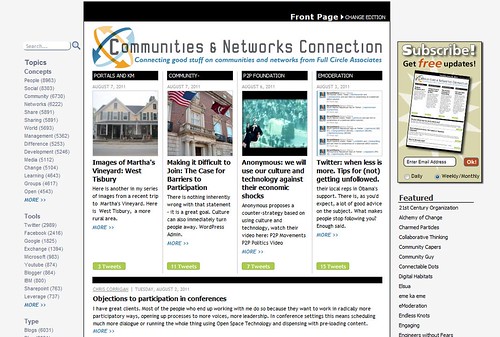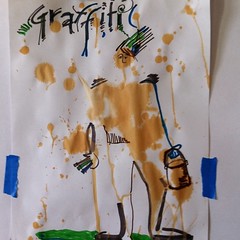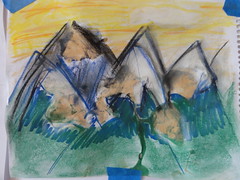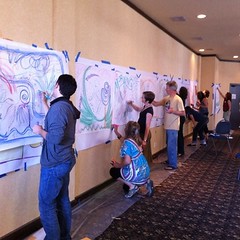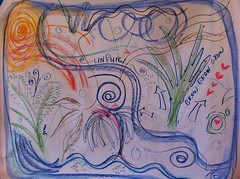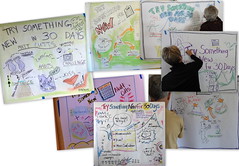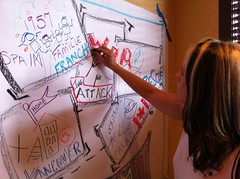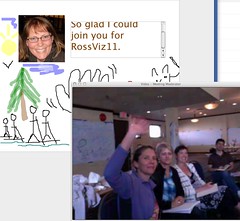 My friend and mentor-of-many domains, Barbara Ganley, asked me to offer a guest post related to my gardens sin her Open View Garden blog. This week I finally feel some inspiration — we’ve had more than a spattering of days that an legitimately be described as a warm sunny day here in Seattle. I debated about cross posting… What does gardening have to do with onsline communities, facilitation or technology stewardship, right?
My friend and mentor-of-many domains, Barbara Ganley, asked me to offer a guest post related to my gardens sin her Open View Garden blog. This week I finally feel some inspiration — we’ve had more than a spattering of days that an legitimately be described as a warm sunny day here in Seattle. I debated about cross posting… What does gardening have to do with onsline communities, facilitation or technology stewardship, right?
In fact at a metaphorical or den spiritual level, these topic have everything to do with each other. They are each about systems, about intent and improvising with whatever you are dealt. They are about finding regeneration, life and beauty wherever we look. So here is what I wrote for Barbara…
Gratefulness: August Garden in a Cool Summer
In mid July we talked about the number of MINUTES of summer we’d had so far. One of the coldest. One of the wettest. I was still in shock that I kept my poor tomato seedlings squished in the too-short cold frame well into June, stunting their growth and productivity. My pea starts grew slower than a glacier. I was morose and relished my week in the sunny warmth of North Carolina. At yoga class, were we try to practice a more positive, accepting attitude, we could not stop those little comments about the weather.
(Have I ever mentioned that as I get older, I crave light, sun, and warmth more than I ever did before? I do. I”ll say it again. I do!)
Now a month later I walked out into my garden and realized the abundance is there this year, but in a different way. I was just not looking at it through the eyes of abundance. So here is a little tour from our small garden.
For those who don’t know my geography, I live in Seattle, in a neighborhood called Ravenna or Ravenna-Bryant (we are actually smack dab between three named neighborhoods. So identity is always a bit tricky.) Our lot is 50 feet wide and 100 feed deep. Our little house sits towards the back of the lot, so our front yard is both our front yard and our back yard. 🙂 We put in raised beds the summer after we moved here in 1984. Over the years, we’ve hacked back the overgrown shrubs, removed most of the lawn and replaced them with plantings, patio and deck, to enjoy “outdoor rooms” even though the weather here doesn’t always encourage our venturing forth.

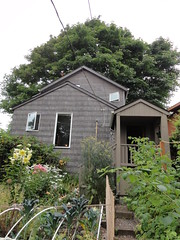 The lot is bracketed by three very large trees – so large that when you fly over the area on the way to a landing at the airport (approach from the North) you can spot our house easily. It’s the one you can’t see underneath the three big trees! To the southeast there is a huge old horse chestnut on the corner of our neighbor’s lot. It drops blossoms, chestnuts (watch your head!) and leaves in abundance. I only wish the darn nuts were edible. They keep the squirrels busy in the fall, burying and losing them. We have, needless to say, many small horse chestnut starts all around the place.
The lot is bracketed by three very large trees – so large that when you fly over the area on the way to a landing at the airport (approach from the North) you can spot our house easily. It’s the one you can’t see underneath the three big trees! To the southeast there is a huge old horse chestnut on the corner of our neighbor’s lot. It drops blossoms, chestnuts (watch your head!) and leaves in abundance. I only wish the darn nuts were edible. They keep the squirrels busy in the fall, burying and losing them. We have, needless to say, many small horse chestnut starts all around the place.
To the east, directly behind our house, is a big old maple we estimate to be just under 100 years. It is our air conditioning in warm years, shading the house from the hot afternoon sun. In the cool, cloudy summers, I admit I curse her a bit. The arborist tells us the tree is healthy, but heading towards its natural decline as the trees usually live about 100 years. Ours has a lovely vase-branching structure, so there are no humongous branches to fall and crush things. Thank goodness.
On the north east corner sits the sisters: two trees, one on our property and one on the neighbors, but growing root to root, trunk to trunk. Ours is an old Douglas fir which I estimate is about 80 feet tall. The other is a pine that is infected with some disease that is slowly killing it. These two so block the rain that the chicken cook beneath it stays dry unless the rain is blowing vertically from winter’s southerly gales. Between these three grand dames, you can imagine … I have little full time sun on my garden and it is diminishing by the year. Our raspberries are less sweet. Our greens and peas less robust, robbed of sun. But our ferns and hostas are lush. Thank goodness for shade plants.
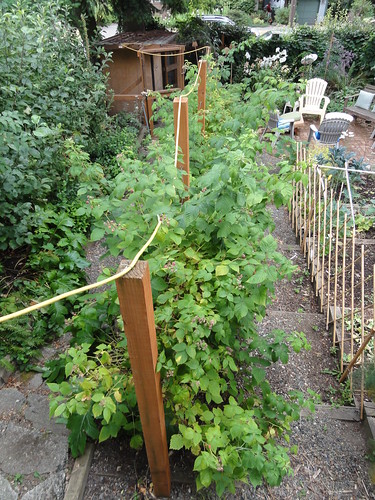 But I want to talk about the food that comes out of the garden, and the flowers, like the huge, fragrant “Conc’d Or” (sp?) lillies on my dining room table, the raspberries in my freezer and the dozen eggs in the fridge, courtesy of “the girls” — our three urban chickens ensconced in their cleverly overbuilt coop. The dinosaur kale, the amazing Japanese cucumber that has thrived despite the weather. The clusters of small, green tomatoes on the vines in our “Earthtainer.” The few slender green beans that survived grazing by the chickens. (Oh, and the second planting of sugar snap peas totally destroyed by the chickens and my not so clever fencing…)
But I want to talk about the food that comes out of the garden, and the flowers, like the huge, fragrant “Conc’d Or” (sp?) lillies on my dining room table, the raspberries in my freezer and the dozen eggs in the fridge, courtesy of “the girls” — our three urban chickens ensconced in their cleverly overbuilt coop. The dinosaur kale, the amazing Japanese cucumber that has thrived despite the weather. The clusters of small, green tomatoes on the vines in our “Earthtainer.” The few slender green beans that survived grazing by the chickens. (Oh, and the second planting of sugar snap peas totally destroyed by the chickens and my not so clever fencing…)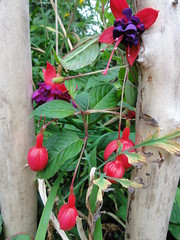
As I look around, I see the horseradish loves the mild summer. That the growth on the apple trees and berries promises good harvests next year. That the hard work I did to amend the neglected soil over the winter DID pay off, even if the bounty is modest. I made two batches of jam this week with the berries, augmented with apricots and some rosemary I had to appropriate from a hedge on a walk, as mine were wiped out by a sudden freeze late last Fall. How glorious the jars look, how delicious the jam tastes. How appreciative friends will be when they receive them in the winter holidays. (If I can stop myself from eating all the jam up myself.)
I think of the three rows of potatoes planted in my friend’s sunnier, larger yard north of Seattle, how we weeded and prepped the rows together, and how she has shared half the harvest. The first row is in and I have eaten creamy new potatoes with home made pesto – even if I had to buy the basil from the farmers market.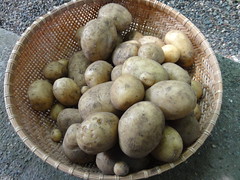
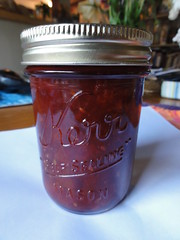 I can sit out on my patio. The wifi even reaches there. Or the deck to the south of the house, where I also relish drying my laundry when the weather permits. It smells so good. I can eat bread and jam, jam and bread. I can talk to the chickens and listen as they talk to me. I can hear the scolding crows (who scare the chickens) and blue jays. Watch for humming birds on the cape fuschias. Holler out to neighbors, now that we’ve hacked down the 20 food holly hedge (not so friendly!) It is amazing what cutting down a hedge will do, or placing some comfy chairs around a small round patio made of bricks reclaimed from a neighbor’s chimney when they remodeled.
I can sit out on my patio. The wifi even reaches there. Or the deck to the south of the house, where I also relish drying my laundry when the weather permits. It smells so good. I can eat bread and jam, jam and bread. I can talk to the chickens and listen as they talk to me. I can hear the scolding crows (who scare the chickens) and blue jays. Watch for humming birds on the cape fuschias. Holler out to neighbors, now that we’ve hacked down the 20 food holly hedge (not so friendly!) It is amazing what cutting down a hedge will do, or placing some comfy chairs around a small round patio made of bricks reclaimed from a neighbor’s chimney when they remodeled.
There are signs of community everywhere. In nature’s community responding to a wet, cold summer. In the human and animal neighborhood. Opening my eyes, reframing my perspective, I see potential where before I saw dark, grey, soddenness. From mud to jam.
Gratefulness is powerful.
Apricot/Berry/Rosemary Jam
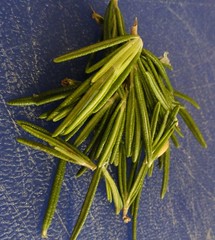 Inspired from FoodinJars , Mrs. Wheelbarrow, and Open View Gardens (for the French maceration approach)
Inspired from FoodinJars , Mrs. Wheelbarrow, and Open View Gardens (for the French maceration approach)
5 cups apricots – sweet, mushy and pitted
1 cup of berries – raspberries, blackberries – -whatever
juice of 2 lemons
3 cups sugar
1-3 teaspoons of finely chopped fresh rosemary. Yes, rosemary. Go light if you are shy…
Directions
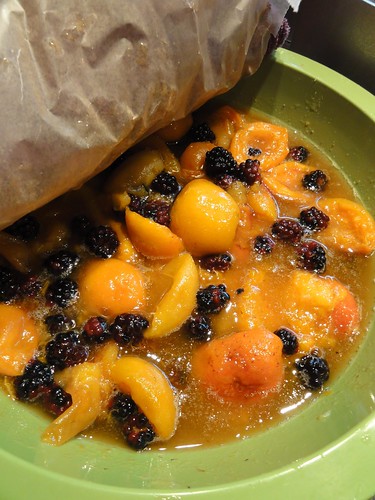 Wash, pit, and measure fruit into a large glass or plastic bowl. Finely chop and add rosemary. (Doesn’t everyone like green bits in their jam?) Mush things around a bit and then cover and refrigerate over night. I forgot and let mind sit two nights. (I also made this without the maceration and twice boil method – just boiled the whole lot for 15 minutes. It was good too!)
Wash, pit, and measure fruit into a large glass or plastic bowl. Finely chop and add rosemary. (Doesn’t everyone like green bits in their jam?) Mush things around a bit and then cover and refrigerate over night. I forgot and let mind sit two nights. (I also made this without the maceration and twice boil method – just boiled the whole lot for 15 minutes. It was good too!)
When ready to cook the jam, sterilize your jars, lids, rims etc. (Read good advice from others listed above for all the details!)
Drain the liquid from the fruit into a large non-aluminum pan and gently bring to a boil up to 220 degrees F. Add back in the fruit, bring to a boil you can’t stir down and cook for 5 minutes or until the jam coats the back of a spoon thickly. Take off heat, pour into your nice clean jars, put on caps and rims making sure your jar tops are wiped clean and process in a boiling hot water bath for 10 minutes. (Again, read their recipes for all the how-to’s. They all have great blogs)
Take the jars out of the hot water bath (carefully), cool, label, share and enjoy!
Full Garden photoset here.
 I have lost track of my blog readers, buffeted by eddies of excess digital content. I stumbled back upon D’Arcy Norman’s blog this afternoon with pure delight. (The is one of his Creative Commons licensed photos on Flickr … sometimes I prefer to just watch someone’s Flickr stream instead of read so much. Does anyone have a suggestion on how to set that up on an iPad for an idiot like me?)
I have lost track of my blog readers, buffeted by eddies of excess digital content. I stumbled back upon D’Arcy Norman’s blog this afternoon with pure delight. (The is one of his Creative Commons licensed photos on Flickr … sometimes I prefer to just watch someone’s Flickr stream instead of read so much. Does anyone have a suggestion on how to set that up on an iPad for an idiot like me?) My friend and mentor-of-many domains, Barbara Ganley, asked me to offer a guest post related to my gardens sin her
My friend and mentor-of-many domains, Barbara Ganley, asked me to offer a guest post related to my gardens sin her 
 The lot is bracketed by three very large trees – so large that when you fly over the area on the way to a landing at the airport (approach from the North) you can spot our house easily. It’s the one you can’t see underneath the three big trees! To the southeast there is a huge old horse chestnut on the corner of our neighbor’s lot. It drops blossoms, chestnuts (watch your head!) and leaves in abundance. I only wish the darn nuts were edible. They keep the squirrels busy in the fall, burying and losing them. We have, needless to say, many small horse chestnut starts all around the place.
The lot is bracketed by three very large trees – so large that when you fly over the area on the way to a landing at the airport (approach from the North) you can spot our house easily. It’s the one you can’t see underneath the three big trees! To the southeast there is a huge old horse chestnut on the corner of our neighbor’s lot. It drops blossoms, chestnuts (watch your head!) and leaves in abundance. I only wish the darn nuts were edible. They keep the squirrels busy in the fall, burying and losing them. We have, needless to say, many small horse chestnut starts all around the place. But I want to talk about the food that comes out of the garden, and the flowers, like the huge, fragrant “Conc’d Or” (sp?) lillies on my dining room table, the raspberries in my freezer and the dozen eggs in the fridge, courtesy of “the girls” — our three urban chickens ensconced in their cleverly overbuilt coop. The dinosaur kale, the amazing Japanese cucumber that has thrived despite the weather. The clusters of small, green tomatoes on the vines in our
But I want to talk about the food that comes out of the garden, and the flowers, like the huge, fragrant “Conc’d Or” (sp?) lillies on my dining room table, the raspberries in my freezer and the dozen eggs in the fridge, courtesy of “the girls” — our three urban chickens ensconced in their cleverly overbuilt coop. The dinosaur kale, the amazing Japanese cucumber that has thrived despite the weather. The clusters of small, green tomatoes on the vines in our 

 I can sit out on my patio. The wifi even reaches there. Or the deck to the south of the house, where I also relish drying my laundry when the weather permits. It smells so good. I can eat bread and jam, jam and bread. I can talk to the chickens and listen as they talk to me. I can hear the scolding crows (who scare the chickens) and blue jays. Watch for humming birds on the cape fuschias. Holler out to neighbors, now that we’ve hacked down the 20 food holly hedge (not so friendly!) It is amazing what cutting down a hedge will do, or placing some comfy chairs around a small round patio made of bricks reclaimed from a neighbor’s chimney when they remodeled.
I can sit out on my patio. The wifi even reaches there. Or the deck to the south of the house, where I also relish drying my laundry when the weather permits. It smells so good. I can eat bread and jam, jam and bread. I can talk to the chickens and listen as they talk to me. I can hear the scolding crows (who scare the chickens) and blue jays. Watch for humming birds on the cape fuschias. Holler out to neighbors, now that we’ve hacked down the 20 food holly hedge (not so friendly!) It is amazing what cutting down a hedge will do, or placing some comfy chairs around a small round patio made of bricks reclaimed from a neighbor’s chimney when they remodeled. Inspired from
Inspired from  Wash, pit, and measure fruit into a large glass or plastic bowl. Finely chop and add rosemary. (Doesn’t everyone like green bits in their jam?) Mush things around a bit and then cover and refrigerate over night. I forgot and let mind sit two nights. (I also made this without the maceration and twice boil method – just boiled the whole lot for 15 minutes. It was good too!)
Wash, pit, and measure fruit into a large glass or plastic bowl. Finely chop and add rosemary. (Doesn’t everyone like green bits in their jam?) Mush things around a bit and then cover and refrigerate over night. I forgot and let mind sit two nights. (I also made this without the maceration and twice boil method – just boiled the whole lot for 15 minutes. It was good too!)